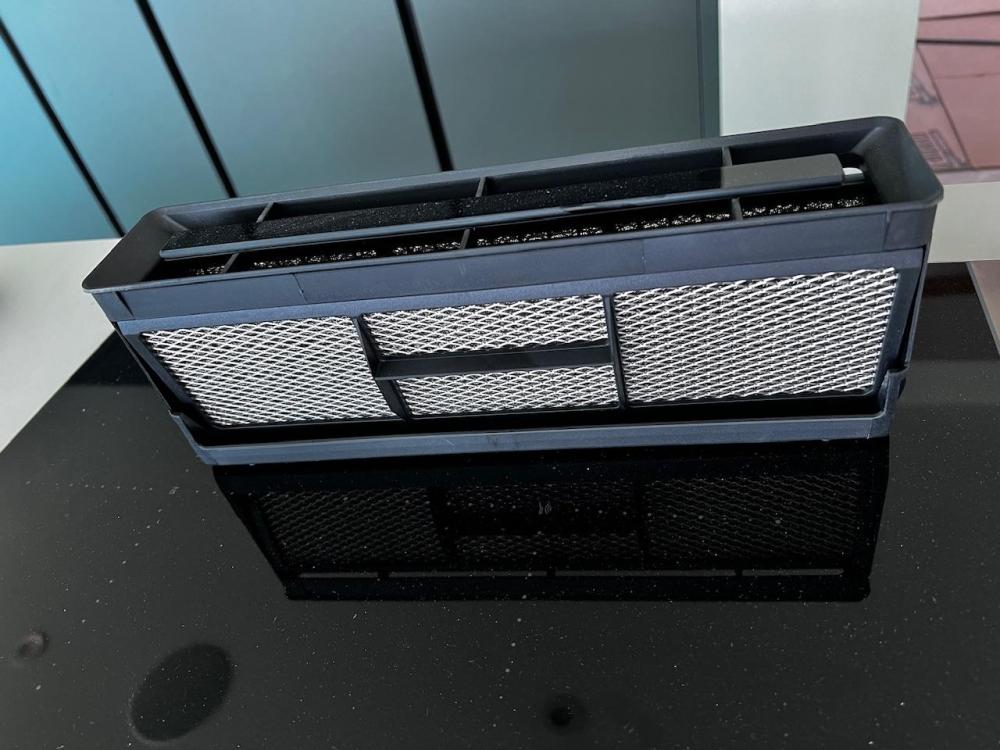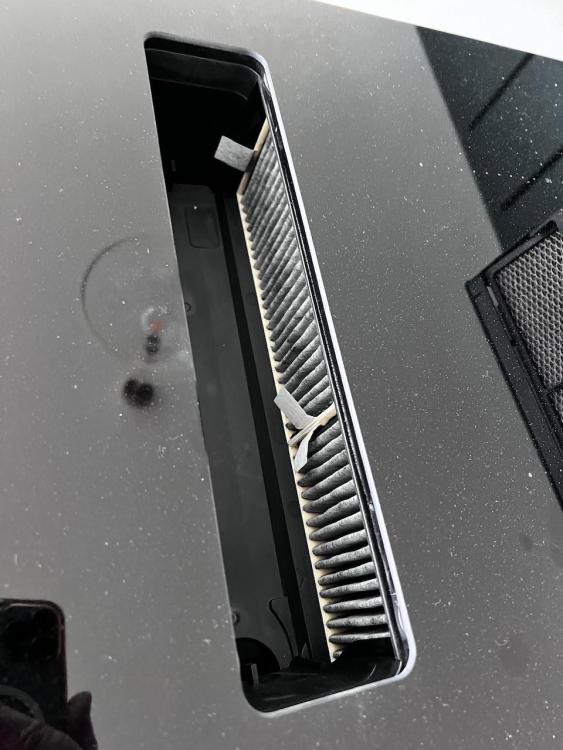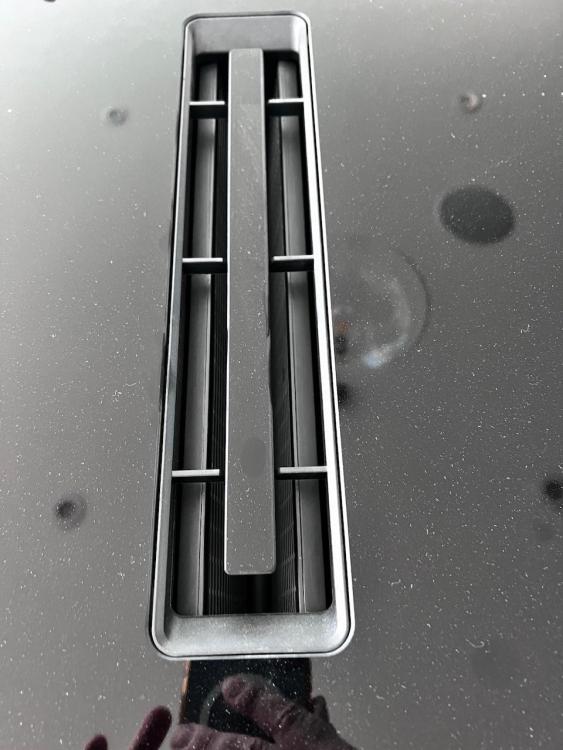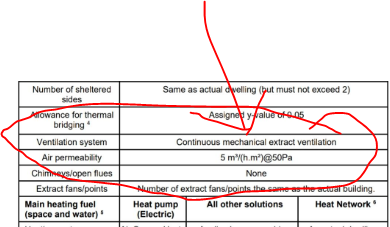Leaderboard
Popular Content
Showing content with the highest reputation on 04/15/24 in all areas
-
We're not passive, but pretty well insulated and achieved 1.6 on the air test. We have had our MVHR running 24/7/365 for over 6 years now (except when changing filters). We have one program for winter, and one for summer, and we occasionally put the boost on (to clear cooking smells a little faster). We never open windows. Doors are for going through and closed immediately. Excellent air quality was the primary goal, and that's exactly what we have. What's more, not only have we never had a musty smell, never mind any mould, but the house stays virtually dust (and allergen) free. Best of all, and despite a degenerative lung condition, my wife is still enjoying better health than she did prior to living here. We wouldn't, and she probably couldn't, live in a home without MVHR ever again.3 points
-
You could make the same point about the central heating. Is that as valid? We fitted our MVHR ourselves. It cost us less than £3K, IIRC. When I did the heating calcs the air recirc losses on the top 2 floors meant that we would have definitely needed some form of central heating solution for these upper floors without it. This would have cost us a lot more than the install cost of the MVHR. We just leave ours running 24 × 365. The running cost is in the noise compared to the heat recovery energy savings during net heating days. And as @dpmiller points out: fresh air and no damp year-round. And yes, in the summer we open windows as and when desired or needed. The MVHR still keeps the wet rooms and unused bedrooms fresh.3 points
-
I have just been away since Thursday visiting. Was like a breath of fresh coming home, light, fresh airy feel, as soon as you walk in the door. Good old MVHR.2 points
-
I disagree. I think it's a knowingly unpopular move led by clear science on particulate emissions. But let's just agree to disagree on this.2 points
-
I see a few mentions of the expense of MVHR. I self installed a simple system complete for less then £1500 in a 260m2 house. It has no sensors just manual boost which we use occasionally, otherwise it stays on trickle rate 24/7, even when some doors and windows are open. Really happy with the air quality (which I monitor with sensors), best value for money in the whole project and a no brainer in a new house IMO.2 points
-
If you don't use a prepared for- or installed- MVHR how do you deal with humidity and "odours" in the wetrooms?2 points
-
1 point
-
The pex-al stuff is crazy hardy tbf, and most UFH installs I do on heated constructional slabs have either us or follow-on trades walking on them, sometimes for days, without any detriment. Damage to this type of pipe has to be near malicious for this to leak.1 point
-
I've done it on a large scale, twice I think, and it was fine. Just a bit of a risk if there were any leaks (breaking out a structural slab) or of a concretor walking on pipes and damaging them. Structurally it isn't any issue at all. More important is whether you want the slab to be thick and act as a heat sink, or be thin and more responsive. My preference is the latter: a thin concrete screed covered in lots of insulation then a top screed as your finished surface. Says who, if not your SE?1 point
-
I am off to Buckinghamshire tomorrow, if there is any on the way I can pick it up.1 point
-
What make of diverter is it? If it's a Myenergi Eddi, you can check the app to see if it's been running. But i guess if it is, then you'll already have done that. Another way to check would be to get a power monitor with a current clamp. Install it on the live to the diverter and monitor the usage. Simon1 point
-
Just glad I built my home when I did! Been heating with just home grown wood since the summer of 2020. I have spent less than a tenner on heating since then. All the wood burned has been grown meters from our door. Every tree removed has been replanted and more, with lots of coppicing. An added benefit is that I have used the by products from this way of life to transform my garden soil (chips, leaves, biochar) this is now rich and being enjoyed by all on my property from woodcutter to worm! A unique situation, but works just fine. Everybody is in good health. I am still unsold on some other forms of renewable energy, (what happens to solar panels when they decrease in efficiency? where do wind turbine blades go likewise?, where do batteries come from, is it sustainable? My supply chain is simple, the technology is simple.1 point
-
Thank you! I’ll message @Moonshine and @Redbeard directly. @markharro I will message you about the invis tape as I may be able to help!1 point
-
1 point
-
1 point
-
If your immersion has a local isolating switch, turn that off and see if the rogue power stops.1 point
-
I installed 1 row of tiles at the eaves, and used fake lead flashing under the tray to the top of this row, it looked a better option than the panels into the gutter. I mentioned some of it in This blog, but I'll look later if I have any pictures of this flashing detail.1 point
-
1 point
-
Hi all. Twenty years ago I bought a derelict bungalow dating back to the early 1900's, more or less knocked it down to the foundations and rebuilt it myself, learning to DIY in a truly epic and clueless Grand Designs "living in a caravan over winter with a pregnant wife" type way. Before I finally finished this place and got the skirting boards on, my family out grew it. We couldn't afford to buy a more suitable, bigger house so started looking at other options. After half a year I managed to buy a massive, half converted, derelict 200 year old Chapel... I guess this is the start of another journey of self discovery, madness and potential financial ruin for me1 point
-
i have a part roll of tescon Vana knocking about, i probably need 6m off it, and you are welcome to the rest.1 point
-
Well the perimeter was set by the vertical edge insulation. My ground workers used a laser level with a square of ply attached to their staff which they used to keep checking the concrete surface level, a little crude but it worked. The two pumping guys handled all that side of things so we could concentrate on the spreading, compacting and levelling. Yes pleased with the end result - probably no more than 10mm out of level looking at the subsequent rainwater on the surface. We now have the attached sitting on it - that's four days work for six men and a crane.1 point
-
Thanks for that. I have got plasterboard sheets ready to go to the tip. This looks like a cheaper way to dispose of them. So, from top down: Chipboard floor (for now) 50mm of fluffy stuff like Rockwool Sound Insulation Slab (35kg/m2) 1-2 layers of platerboard offcuts between rafters, as tight fitting as I can (or sand along the edges if I'm feeling obsessive) Current 12.5mm plasterboard ceiling Air paths are sealed through the ceiling, but not the chipboard floor as I keep lifting it for stuff. It's funny you mention sand, I came across Quietex which is crushed limestone to pour into ceiling voids to improve acoustic performance. I thought it weird but as it's mass it makes sense. I have enough headroom in my office that resilience bars are a good shout. Ditto for putting rubber above the joists to cushion impact onto the chipboard. I didn't know any of that, so many thanks. This site's an education every time!1 point
-
Most trades are on fixed price. Some are on time+materials. While some trades may sit on their arse drinking tea and playing cards all day if they are paid by the hour, this has not been my experience. I seem to have good trades who are happy to get on with the job even when paid by the hour. I suspect such productivity stems from their relationship with my builder. I reckon if I ran the project myself and engaged the trades directly they would be more likely to take the piss.1 point
-
Not really. They can burn bottled gas or oil, which probably is less environmentally damaging overall (but only because we already have the infrastructure to produce and distribute it). It will absorb less CO2 than a mature tree by m2. Well not chemically. This is one of the misunderstandings. The atmosphere is a shared resource, tinker with it too much and unexpected things happen. Take the last 6 months in the UK, we have had double our usual rainfall. Now many people will say this is natural variation, or it is because we are in an El Nino period. But double. We have also had another mild winter, I think the last 3 months were record breaking. We just need to stop burning.1 point
-
In reality there’s a difference between “biomass” and burning your own scrap sand coppiced wood (in a rural environment).1 point
-
I have said for ages that is a load of tosh. Thankfully people are recognising that. I look forward to the announcement that DRAX is finally closing.1 point
-
This article makes me think prices of panels have further to fall: https://www.reuters.com/business/energy/losing-hope-rescue-some-european-solar-firms-head-us-2024-04-15/ This part jumps out: So there are significant built up stocks of solar panels and production seems to be increasing faster than consumption. I'm no economist but unless something changes would that not point to serious reductions in prices?1 point
-
Yesterday, in London, the sun got to 48.01° above the horizon. June 21 it will be at 61.93°, December 21 15.06°. You may find that the height of summer is not so bad.1 point
-
I'm by no means an expert in this area, but that's my understanding. Section 73 application to have the condition removed due to the development being exempt. But I'd say speak to the LPA, point them to the guidance on exempt developments, and see what they advise as the most appropriate course of action to remove the condition.1 point
-
It's probably hotter too, so keeps rising away from our noses. 90% efficiency (it feels better than that) using ultra local fuel, even good waste? That must compare well with even wind power, cradle to cradle.1 point
-
i also didn't put any central heating upstairs and i was worried as i'd never lived in a house where that was even possible! but fearing overheating we did put in AC so that could be used for heating if required. i doubt it ever will be. yesterday we were working in the house and the sun was coming through the windows and we had to actually turn the AC on to cool the rooms and it's only April. granted we were plumbing so it might've been ok for just sitting around in but i am now convinced that cooling is more important upstairs than heating in our house.1 point
-
Misunderstanding, what I was saying was it's a replacement project and sometimes not everything has been taken into account or considered and sometimes it's wait and see what to do scenario after discussions with you if need be.1 point
-
Well my car defrosts (one side) when the sun is shining on it (not saying it improves an ASHP,s efficiency just defrosting) however my ASHP was on a western wall and after the sun was shining on the brickwork it radiated heat back at you.. like @ProDave I think it would make a little difference and had planned to time it to run from 11am so the ambient temp was likely to be a little higher.1 point
-
Certainly would help defrost in the sunshine!, Electric heaters usually have three pin plugs so I just made sure sockets were in a suitable location.1 point
-
I only once used intumescent paint on chipboard. The solvents dissolved the glue and the flakes of timber came loose from the face. So I discussed it with the BCO and we painted it with Sandtex, because it stuck without dissolving the resins, and didn't burn. No certificates or anything just common sense. It looks like sandtex though. There was a specific reason I needed lots of OSB left exposed. What's your reason? I switched to using 18mm mdf in subsequent projects with this detail. Intumescent sticks to it fine. Envirograf were the preferred supplier, though loyalty and because they'd mix any colour.1 point
-
Look folks. What is happening in Scotland has nothing to do with science and all to do with political ideology. Trying to rationalise this is not achievable.1 point
-
Wood pellets never made sense. See also, cash for ash in NI1 point
-
If you use a 50 mil metal stud You will be about £18 m2 all in Upto a height of 2.4 for freestanding add 20% for any higher up-to 3000 freestanding1 point
-
I think you are into a case "ask 100 engineers and you get 100 right answers". What you need to do, initially, is break it down into important parts i.e. structural forces, thermal properties, looks, easy of construction, price etc. Then analysis each part and how they go together. Some construction methods have developed over millennia and it is only in the last 250 years that post rationalisation has happened. An example of this is one of my favourite discussions about lime versus Portland Cements. They are both interesting and do their jobs well, but many think that the traditional lime mixes are better 'because the Romans used them' (even though the Egyptians beat them to it by a 1000 years at least). Another example is, as you have found out, is to do with cavities. These are a relatively late development and were originally just a rain screen over a solid structural wall. Trial and error, plus improvements in materials and manufacturing processes, the simple wall has changed to a two walls, tied together, with some being single load bearing, other both load bearing, and sometimes filled with insulation. The designs are used differently for different purposes, sometimes it is just decorative, other times it is structurally important. Another area you will soon find out about is the thermal performance, again, there are many different opinions. Some say that you need the insulation on the inside, other say on the outside, this is because while mathematically the U-Value of a wall is the same in both directions, the energy inputs may not be i.e. a heated house may be putting 5W.m-2 though a wall at night, but when hit by bright sunlight it may go to 100 W.m-2. Totally different regimes for the same structure. Then there is air and water tightness. Traditional masonry walls are inherently 'leaky', so putting insulation in a cavity may cause thermal bypass problems or the insulation type may absorb water. This is why internal insulation (on the room side of both cavities) can give a better performance than the same amount of insulation value within the cavity. The same may be true for external insulation, but could be harder to fit because of roof overhangs and window reveals, but is often easier to install because there are no joists or wires to move (this is more about retro fitting than new builds) So basically, it is hard say if there is a best system, it is a case of 'it depends'. All systems can work well if designed right, just as all systems can fail if executed badly (by twat builders). The main things to keep in mind are: Will it be strong enough Will it keep the weather out Will it look right Will it last Is it affordable (the space station is strong, thermally brilliant and air tight) Can it be repaired and modified That is enough to be going on with I think.1 point
-
thanks, our saving grace is a small pension from when women retired at 60, not enough to cover everything, but does keep the wolf from the door. I'm just a bit annoyed that I've paid many 1000's in NI & tax over my working life, never claimed and now can't get anything. It is good that people who are desperate can get help, but not us until we are destitute. hey ho 🙂1 point
-
I found the same with our build. Heating was a problem that wasn't predicted by our SAP calcs. Fitting an MVHR is a expensive but it does provide a very comfortable living environment in both winter and summer. The energy conservation is a factor year round. Typically our input/output air temperatures are within about 1.5C so in winter with the outside air temperature down at 5C and the house running at 22c the incoming air into the house is at 20.5C having been heated by the outgoing air at 22C. In summer with the A2A cooling on the house is still at 22C with the outside air temperature up to 28C the outgoing air is cooing the incoming air to 23.5, not a lot but it all helps. I was initially concerned over the operation of summer bypass, but it's easily disabled. It's all about saving energy. I'm not sure what the payback period is like but purely in terms of a comfortable environment I'd not want to be without an MVHR.1 point
-
But no two houses/builds react the same to “weather/temps” as no two “people” react to the conditions the same. I remember Jeremy going into minute detail of local weather patterns, designing his own weather curves etc etc But in the end he scrapped it and fitted a single room stat but he still found he needed more cooling than heating which nothing predicted for him. I liked the MVHR I fitted and the house had an airy feel even with all the windows shut, however during warm weather and doors and windows open I would switch it off. I wanted to run it on a CO (is that right Nick?) monitor to detect stale air but was told they are expensive and not that reliable so I ran it on a humidity sensor.1 point
-
We leave the window in our bedroom for much of the summer. I support we could turn the MVHR off but it's so cheap to run and as it guarantees fresh air regardless we don't bother. Despite my statz-esque approach to kids leaving the entrance door open I try to remember a house is there entirely for our benefit and and enjoyment and not as a science project.1 point
-
Also worth knowing that there is an official rating for how well hoods filter the grease, from A (>95%) to G (> or = to 45%). You may have to dig to find it - some manufacturers don't seem keen to make it easy to find in their literature.1 point
-
Extract from my research notes that might be helpful; Recirculating cooker hood with grease (typically steel/aluminium mesh) and charcoal/carbon filters with a MVHR extract vent nearby but not directly coupled. Boost the MVHR rate while cooking if you want to (current sensor on induction hob cable for automation??) Grease filters need cleaning regularly; every 1-3 months Charcoal/carbon filters have a lifetime (usually 3-12 months; check manufacturer specifications) and should be replaced Try to get a model with grease filters that can go (and fit) in the dishwasher and that will not tarnish, or that can be replaced (should you wish to) SMEG, for example, has a Universal Charcoal filter Stainless Steel AISI 304. The filter can be washed in the dishwasher at 50°C (water and suitable detergent) and to dry, put in the oven 180°C for 25 minutes1 point
-
1 point
-
They should stay banned. A new house built well to the new standards would overheat with them anyway in most cases.1 point
-
I noticed that too. While the U values are good the air tightness is still poor.1 point
-
Can the ridge beam be brought down so the rafters sit on top? Means no cold bridge at the ridge and a simpler fixing detail.1 point
-
Bear in mind blown in cavity insulation (new build or refurb) is notifiable under the Building Regs. Product should carry 3rd party certification (BBA or similar) and be installed by approved contractor.0 points
This leaderboard is set to London/GMT+01:00






















